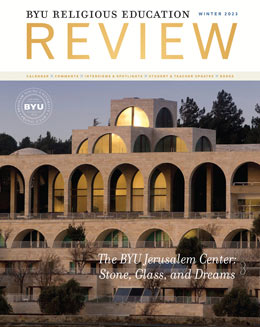Abby Larkins is an editing intern at the BYU Religious Studies Center.
Barbara Morgan Gardner is an associate professor of Church history and doctrine at BYU. She is the author of the book The Priesthood Power of Women in the Temple, Church, and Family, and she is passionate about helping women in the Church rise to their spiritual privileges. Sister Gardner invites all female Latter-day Saints “to become a generation of women who know, understand, and use God’s priesthood power.”[1] The answers to the following questions come from her past publications in the Religious Educator.
What do you feel is the best way to empower young adult women in the Church?
Helping sisters become confident in their ability to study and learn from the scriptures, especially regarding the priesthood and the temple, is critical. If we, as teachers, can be a guide by their side rather than a sage on the stage, it will help the sisters become more spiritually self-reliant. Some scriptures we can help guide our students to include, but are not limited to, Doctrine and Covenants sections 2, 13, 20, 76, 84, 95, 107, 110, 121, and 124, as well as Alma 13. . . . Attending the temple for the purpose of faithfully seeking not only for answers but especially for inspired questions regarding the topic cannot be overemphasized.[2]
How can young adult women find empowerment through scripture study, especially when there are so few women mentioned by name in the scriptures?
President Ballard instructed members to “develop the skill to find [women’s] influence” even when they aren’t specifically mentioned. He continued, “As we look for and find women in our scriptures and in our history, we will see far better the power and influence women have in our family, community, the Church, and the world.”[3]. . .
Note how seamlessly President Benson included women in the context of [verses 6–16 in Doctrine and Covenants 84]:
“The order of priesthood spoken of in the scriptures is sometimes referred to as the patriarchal order because it came down from father to son.
But this order is otherwise described in modern revelation as an order of family government where a man and woman enter into a covenant with God—just as did Adam and Eve—to be sealed for eternity, to have posterity, and to do the will and work of God throughout their mortality.”[4]
President Benson naturally included Eve with Adam because Adam and Eve needed each other to enter the patriarchal priesthood in order to have a family. The patriarchal priesthood is all about family. . . .
Through their covenants with God in the temple, both women and men receive priesthood power and authority, regardless of marital status.[5]
How can CES leaders better teach about Heavenly Mother?
Heavenly Mother had become somewhat of a taboo topic among Latter-day Saints over the years. Some state that, among many erroneous reasons, perhaps the General Authorities and the Lord didn’t speak about her in order to protect her. In a 2011 publication, however, republished on lds.org, David L. Paulsen and Martin Pulido compiled over six hundred citations (many of which are very recent) of Heavenly Mother from prophets, apostles, and other Church authorities since 1844. [6]
For many, [statements on Heavenly Mother are] a critical part of the answer to the questions, who are we, why are we here, and where are we going. Hence, we should not shy away from, but rather “look for,” and even “relish,” the opportunity—especially as CES teachers—to talk about our Heavenly Mother! In so doing, let us also be wise to teach, following the pattern of Jesus Christ, that we “pray unto the Father in His name.” President Hinckley reminds us, “The fact that we do not pray to our Mother in Heaven in no way belittles or denigrates her.”[7] For a more comprehensive understanding of the topic, LDS.org has a First Presidency and Quorum of the Twelve–approved essay entitled “Mother in Heaven.”[8]
Notes
[1] Barbara Morgan Gardner, “5-minute Fireside: Women and Priesthood Power,” LDS Living, January 13, 2020, YouTube video, https://
[2] Gardner, “Helping Female Students Rise to Their Spiritual Privileges,” Religious Educator 18, no. 3 (2017): 117–140.
[3] M. Russell Ballard, “Women of Dedication, Faith, Determination, and Action” (Brigham Young University women’s conference address, May 1, 2015), 7.
[4] Ezra Taft Benson, “What I Hope You Would Teach your Children about the Temple,” Ensign, August 1985, 8.
[5] Gardner, “Using Section 84 to Emphasize the Priesthood Power of Women,” Religious Educator 22, no. 2 (2021): 73–95.
[6] David L. Paulsen and Martin Pulido, “A Mother There: A Survey of Historical Teachings about Mother in Heaven,” BYU Studies 50, no. 1 (2011); emphasis added.
[7] Gordon B. Hinckley, “Daughters of God,” Ensign, November 1991, 100.
[8] See “Mother in Heaven,” lds.org/
